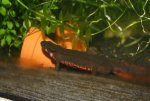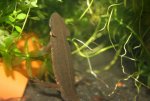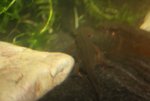idontthinkso
New member
- Joined
- Nov 1, 2013
- Messages
- 38
- Reaction score
- 0
- Points
- 0
- Country
- Netherlands
I moved my 1.1.C Pyrrhogasters to another tank (60cm). Since then the female doesnt eat much, but the male seems to not eat at all. But they moved over 1 month ago, so im sure they do eat. I also gave them live food. They do eat but very little. Usually earthworms are devoured, but now it takes a long time for them to finish eating , if they do eat them ! The only thing is they are in a tank with , lets say 50 red cherry shrimp. So perhaps they are eating them (cause its also the first time they meet red cherry shrimps), though i never saw that, i even saw 1 shrimp swimming right towards the male and eating a mosquito larvae without him attacking the shrimp.
I added some pictures. Does he look healthy ?
How much time do they need to feel good in a new environment ?
The decoration etc. is basically the same.
I added some pictures. Does he look healthy ?
How much time do they need to feel good in a new environment ?
The decoration etc. is basically the same.





